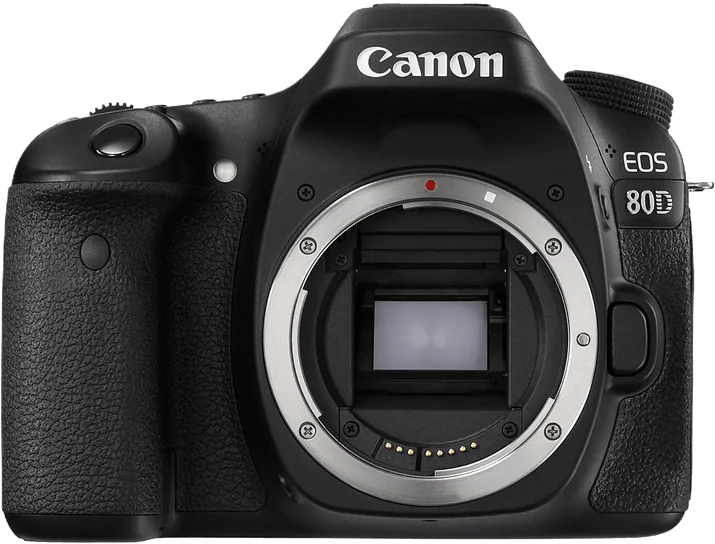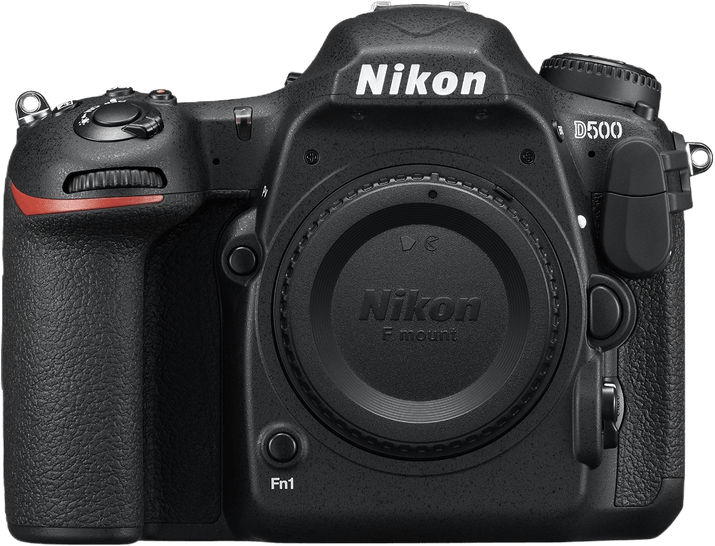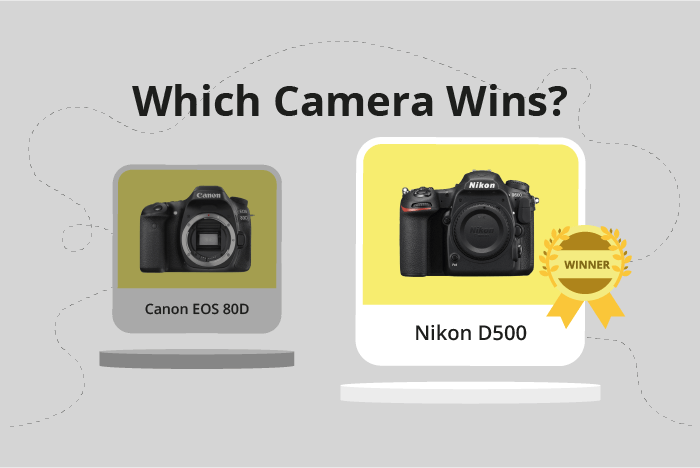Canon EOS 80D vs Nikon D500 Comparison
Canon EOS 80D

Nikon D500

The Nikon D500 emerges as the winner with a score of 75/100, while the Canon EOS 80D trails behind at 64/100. Both cameras are DSLRs released in 2016, with the D500 being slightly larger and heavier than the 80D. The Nikon D500 excels with a higher score due to its superior performance, justifying its higher launch price of $2000 compared to the 80D’s price of $1200.
On the other hand, the Canon EOS 80D does have an advantage in terms of size and weight, being more compact and lighter than the Nikon D500. This makes it more convenient for travel or extended periods of use.
Taking these factors into consideration, the Nikon D500 proves to be a better camera in terms of performance, while the Canon EOS 80D offers a more lightweight and portable option.
Canon EOS 80D vs Nikon D500 Overview and Optics
The Nikon D500 outperforms the Canon EOS 80D in optics with a score of 69/100 compared to 63/100. Both cameras share some common specifications, including a CMOS sensor, APS-C sensor size, and the absence of image stabilization. Additionally, they both have a compatible lens mount, with the Canon 80D using the Canon EF-S mount and the Nikon D500 using the Nikon F DX mount.
The Nikon D500 excels in several areas, such as its shooting speed, which is faster at 10 frames per second compared to the Canon 80D’s 7 frames per second. The D500 also boasts a superior processor, the Expeed 5, compared to the Canon 80D’s Digic 6 processor. The D500’s sensor quality is higher, with a DXOMARK score of 84, while the Canon 80D’s sensor scores 79.
On the other hand, the Canon EOS 80D has a higher megapixel count of 24.2, compared to the Nikon D500’s 20.9 megapixels. This advantage allows the Canon 80D to capture more detailed images, which can be beneficial for those prioritizing image resolution.
Considering the optics performance, the Nikon D500 is the better option due to its faster shooting speed, better processor, and higher sensor quality. These features make it a more suitable choice for photographers who demand rapid and high-quality image capturing. However, the Canon EOS 80D offers a higher megapixel count for those seeking greater image resolution. Ultimately, the choice between these two cameras depends on the specific needs and preferences of the photographer.
Canon EOS 80D vs Nikon D500 Video Performance
The Canon EOS 80D and Nikon D500 both have a video score of 70/100. Despite having the same score, there are differences in their video capabilities. Both cameras have time-lapse functionality built in, which is beneficial for capturing motion over an extended period.
The Nikon D500 has an advantage in video resolution, offering 4K (3840 x 2160) compared to the Canon EOS 80D’s Full HD (1920 x 1080). This means the D500 can capture more detailed and higher quality videos than the 80D. However, the Canon EOS 80D has a higher max video frame rate of 60fps, compared to the Nikon D500’s 30fps. This allows the 80D to produce smoother footage, especially when recording fast-moving subjects or for slow-motion effects.
While the Nikon D500 excels in video resolution, the Canon EOS 80D’s higher frame rate provides an advantage in certain situations. Based on these differences, the choice between the two cameras depends on the user’s priorities. If higher video quality and detail are essential, the Nikon D500 is the better option. On the other hand, if smoothness and capturing fast action are more important, the Canon EOS 80D is the ideal choice.
Considering the video capabilities of both cameras, there is no clear winner. Each camera has its strengths and weaknesses, and the best choice will depend on individual preferences and needs. Users should weigh the importance of video resolution and frame rate when deciding between the Canon EOS 80D and Nikon D500.
Canon EOS 80D vs Nikon D500 Features and Benefits
The Nikon D500 outperforms the Canon EOS 80D with a feature score of 87/100 compared to the 80D’s 70/100. Both cameras share several specifications, including a touchscreen, flip screen, WIFI connectivity, and the absence of GPS functionality. However, the Nikon D500 excels in certain areas, making it the superior choice in terms of features.
The Nikon D500 boasts a larger screen size of 3.2 inches compared to the Canon EOS 80D’s 3 inches. This difference provides a more comfortable viewing experience for users. Additionally, the D500’s screen resolution is significantly higher at 2,359,000 dots, compared to the 80D’s 1,040,000 dots. This results in clearer and more detailed image previews on the D500.
Another advantage of the Nikon D500 is its Bluetooth connectivity, which the Canon EOS 80D lacks. This feature allows for seamless and effortless pairing with compatible devices for easy sharing and remote control of the camera.
Despite these advantages, the Canon EOS 80D may still be a suitable choice for some users. Its lower feature score does not necessarily mean it is an inferior camera, but rather that it lacks certain features found in the D500. For those who do not require the larger screen size, higher screen resolution, or Bluetooth connectivity, the 80D may still be an adequate option.
Ultimately, the Nikon D500 proves to be the better camera in terms of features, offering a larger, higher-resolution screen and Bluetooth connectivity. However, the Canon EOS 80D may still meet the needs of users who do not prioritize these specific features.
Canon EOS 80D vs Nikon D500 Storage and Battery
The Nikon D500 outperforms the Canon EOS 80D in storage and battery with a score of 79/100, while the Canon EOS 80D scores 43/100. Both cameras share the absence of USB charging and compatibility with SD, SDHC, and SDXC memory cards. However, the Nikon D500 surpasses the Canon EOS 80D with two memory card slots, UHS-II compatibility, and XQD card support.
The Nikon D500 also boasts a longer battery life of 1240 shots, compared to the Canon EOS 80D’s 960 shots. The Canon EOS 80D’s edge lies in its battery type, LP-E6N, which is widely used in other Canon cameras, making it easier for users to find replacements. Despite this advantage, the Nikon D500 remains superior in storage and battery performance.
Canon EOS 80D vs Nikon D500 – Our Verdict
Are you still undecided about which camera is right for you? Have a look at these popular comparisons that feature the Canon EOS 80D or the Nikon D500:

